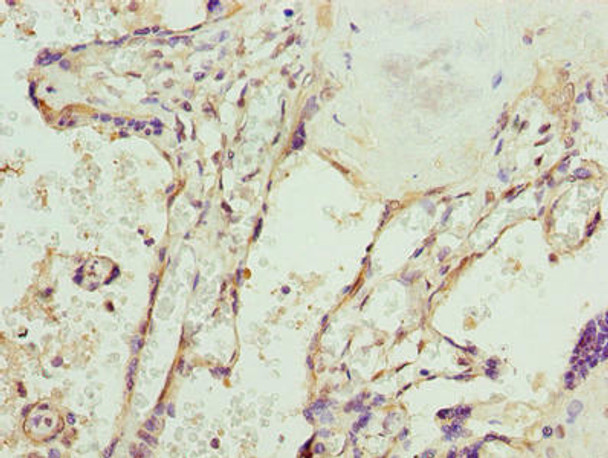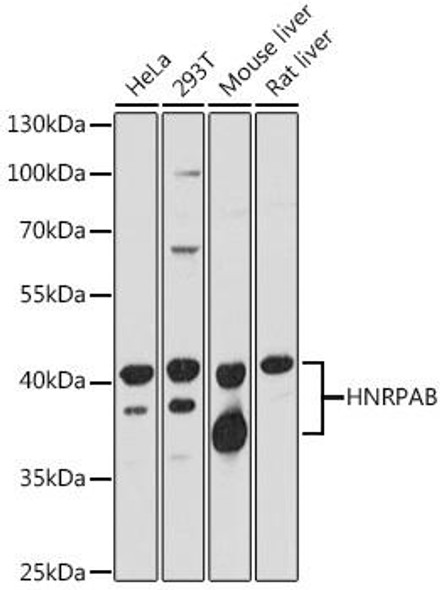Description
SPCS3 Antibody (PACO30100)
The SPCS3 Monoclonal Antibody (PACO30100) is a powerful tool for researchers investigating SPCS3, a crucial component of the signal peptidase complex. This antibody, derived from mouse origin, shows high specificity and sensitivity in detecting SPCS3 in human samples, making it reliable for use in Western blot and immunohistochemistry applications. SPCS3 is known to play a key role in protein trafficking and processing within the endoplasmic reticulum, making it essential for cellular function.
Dysregulation of SPCS3 has been linked to various diseases, including cancer and metabolic disorders, making it a promising target for therapeutic interventions. By using this antibody, researchers can further explore the functions and mechanisms of SPCS3 in normal and diseased cells, advancing our understanding of cellular processes and potential treatment strategies.
| Antibody Name: | SPCS3 Antibody (PACO30100) |
| Antibody SKU: | PACO30100 |
| Size: | 50ug |
| Host Species: | Rabbit |
| Tested Applications: | ELISA, WB, IHC |
| Recommended Dilutions: | ELISA:1:2000-1:10000, WB:1:500-1:2000, IHC:1:20-1:200 |
| Species Reactivity: | Human, Mouse |
| Immunogen: | Recombinant Human Signal peptidase complex subunit 3 protein (33-180AA) |
| Form: | Liquid |
| Storage Buffer: | Preservative: 0.03% Proclin 300 Constituents: 50% Glycerol, 0.01M PBS, PH 7.4 |
| Purification Method: | Antigen Affinity Purified |
| Clonality: | Polyclonal |
| Isotype: | IgG |
| Conjugate: | Non-conjugated |
 | Immunohistochemistry of paraffin-embedded human liver tissue using PACO30100 at dilution of 1:100. |
 | Western blot All lanes: SPCS3 antibody at 0.1µg/ml + Mouse kidney tissue Secondary Goat polyclonal to rabbit at 1/10000 dilution Predicted band size: 21 kDa Observed band size: 21 kDa . |
 | Immunohistochemistry of paraffin-embedded human placenta tissue using PACO30100 at dilution of 1:100. |
| Background: | Component of the microsomal signal peptidase complex which removes signal peptides from nascent proteins as they are translocated into the lumen of the endoplasmic reticulum. |
| Synonyms: | Signal peptidase complex subunit 3 (EC 3.4.-.-) (Microsomal signal peptidase 22/23 kDa subunit) (SPC22/23) (SPase 22/23 kDa subunit), SPCS3, SPC22 |
| UniProt Protein Function: | SPCS3: Component of the microsomal signal peptidase complex which removes signal peptides from nascent proteins as they are translocated into the lumen of the endoplasmic reticulum. Belongs to the SPCS3 family.Protein type: Membrane protein, integral; Protease; Cofactor and Vitamin Metabolism - biotin; EC 3.4.-.-; Amino Acid Metabolism - lysine degradationChromosomal Location of Human Ortholog: 4q34.2Cellular Component: endoplasmic reticulum; endoplasmic reticulum membrane |
| UniProt Protein Details: | |
| NCBI Summary: | |
| UniProt Code: | P61009 |
| NCBI GenInfo Identifier: | 46577648 |
| NCBI Gene ID: | 60559 |
| NCBI Accession: | P61009.1 |
| UniProt Secondary Accession: | P61009,P12280, Q9H0S7 |
| UniProt Related Accession: | P61009 |
| Molecular Weight: | 20,313 Da |
| NCBI Full Name: | Signal peptidase complex subunit 3 |
| NCBI Synonym Full Names: | signal peptidase complex subunit 3 |
| NCBI Official Symbol: | SPCS3 |
| NCBI Official Synonym Symbols: | SPC3; PRO3567; YLR066W; SPC22/23 |
| NCBI Protein Information: | signal peptidase complex subunit 3 |
| UniProt Protein Name: | Signal peptidase complex subunit 3 |
| UniProt Synonym Protein Names: | Microsomal signal peptidase 22/23 kDa subunit; SPC22/23; SPase 22/23 kDa subunit |
| Protein Family: | Signal peptidase complex |
| UniProt Gene Name: | SPCS3 |
| UniProt Entry Name: | SPCS3_HUMAN |













